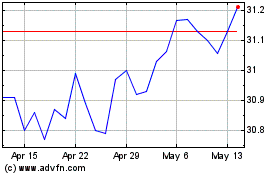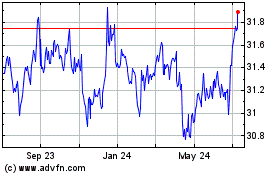Inside This Year’s M&A Boom and the IQ Merger Arbitrage ETF (MNA)
November 25 2014 - 9:00AM
ETFDB
Since the start of 2014, Wall Street has witnessed one of the
most active mergers and acquisition booms in some time. With only a
little more than a month to go, so far this year’s global
merger tally already tops $3 trillion, with U.S. M&A activity
accounting for $1.5 trillion. According to Dealogic, the current
dollar volume of announced deals in the world is higher than in any
full year since 2007 [see also ETF Issuer Solutions Welcomes
Industry Newcomers].
In light of this M&A boom, we’ll take a look at the recent
mega-deals, as well highlight how one particular fund has
tried to capitalize on this boom.
The Highest M&A Activity Since 2007
Global M&A volume totals $3.23 trillion year-to-date, which
is 27% higher than 2013′s volume and the highest YTD volume since
2007, which logged in a volume of $4.08 trillion. Below is a graph
of yearly M&A volumes from Dealogic:

While the majority of the deal volume has targeted the
healthcare sector, there have also been some other mega-deals in
other industries. Some of the largest deals of 2014 include:
- Comcast (CMCSA) Acquires Time Warner Cable (TWC) for $69.8
billion
- Actavis (ACT) Acquires Allergan (AGN) for $66 billion
- AT&T (T) Acquires DirectTV (DTV) for $67.1
billion
- Medtronic (MDT) Acquires Covidien (COV) for $46.8
billion
- Halliburton (HAL) Acquires Baker Hughes (BHI) for $34.6
billion
- Actavis (ACT) Acquires Forest Laboratories (FRX) for $25.3
billion
- Facebook (FB) Acquires WhatsApp for $19.4 billion
It should be noted that not all of these deals have been
approved by regulatory authorities yet.
A Look at the IQ Merger Arbitrage ETF
At its core, Merger Arbitrage ETFs aim to profit from the spread that occurs when an
acquisition is announced and the final purchase price is set.
The IndexIQ Merger Arbitrage ETF (MNA) is one of only a
handful of ETFs that utilizes this popular strategy [see also A
Closer Look at Merger Arbitrage
ETPs].
MNA tracks the IQ Merger Arbitrage Index,
which seeks to achieve capital appreciation by
investing in global companies for which there has been a public
announcement of a takeover by an acquirer. This differentiated
approach is based on a passive strategy of owning certain announced
takeover targets with the goal of generating returns that are
representative of global merger arbitrage activity. The Index also
includes short exposure to global equities as a partial equity
market hedge.
Below, take a look at MNA’s performance year-to-date, relative
to the S&P 500 ETF (SPY):

During the first few months of the year,
where equities entered a steep correction, MNA managed to
outperform the broader market. Once bullish momentum returned, SPY
charged higher, while MNA continued its steady upward trend. MNA
has also managed to outperform its competitors in the merger
arbitrage ETF category.
The Bottom Line
M&A activity has certainly picked up
its pace this year, which for the most part is a positive sign for
the economy. The IndexIQ Merger
Arbitrage ETF (MNA) has also benefited from this uptick in
mega-deals, logging in steady returns throughout the
year.
Follow me on
Twitter @DPylypczak
Disclosure: No positions at time of
writing.
Click here to read the original article on ETFdb.com.
IQ Merger Arbitrage ETF (AMEX:MNA)
Historical Stock Chart
From Mar 2024 to Apr 2024

IQ Merger Arbitrage ETF (AMEX:MNA)
Historical Stock Chart
From Apr 2023 to Apr 2024
